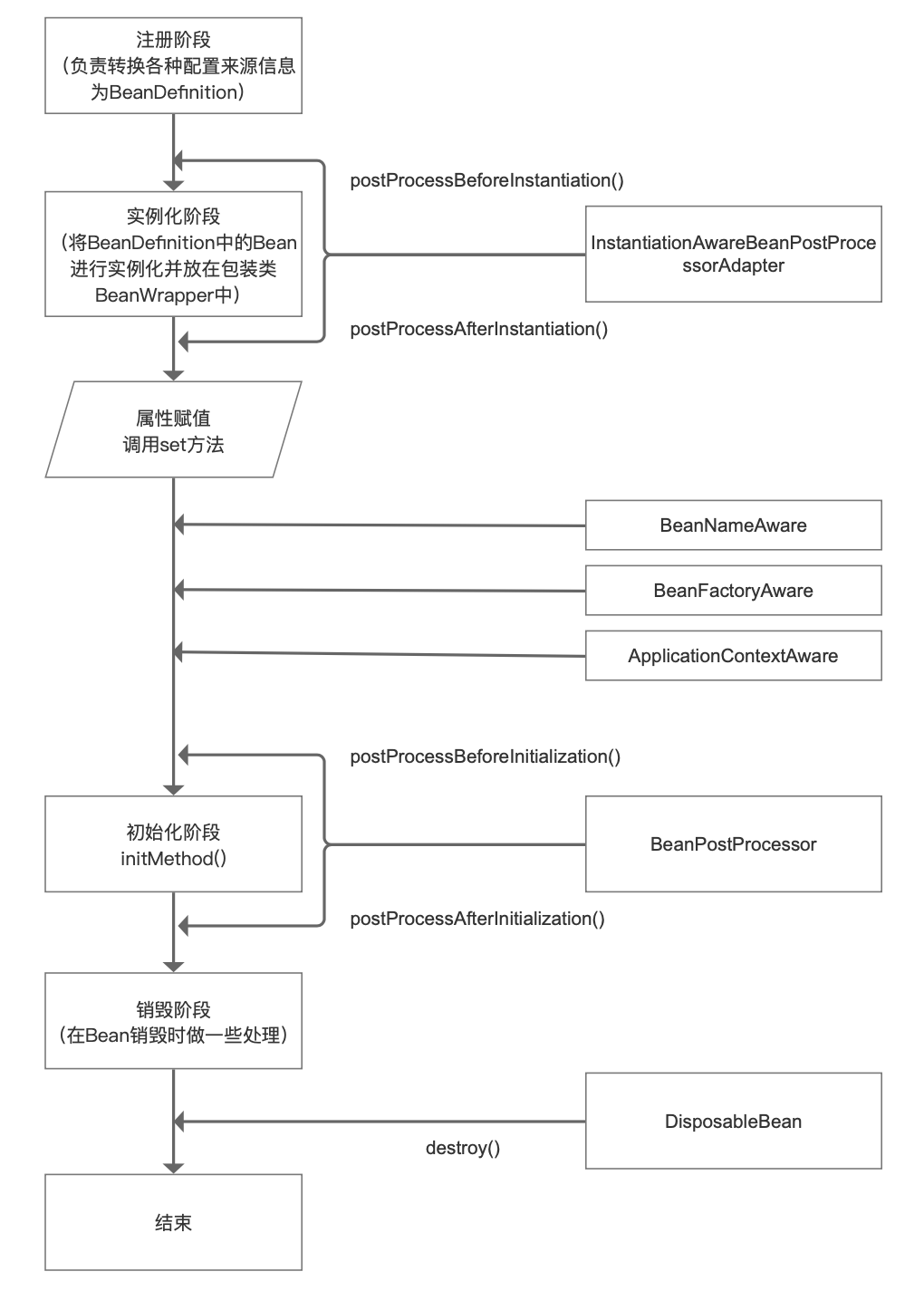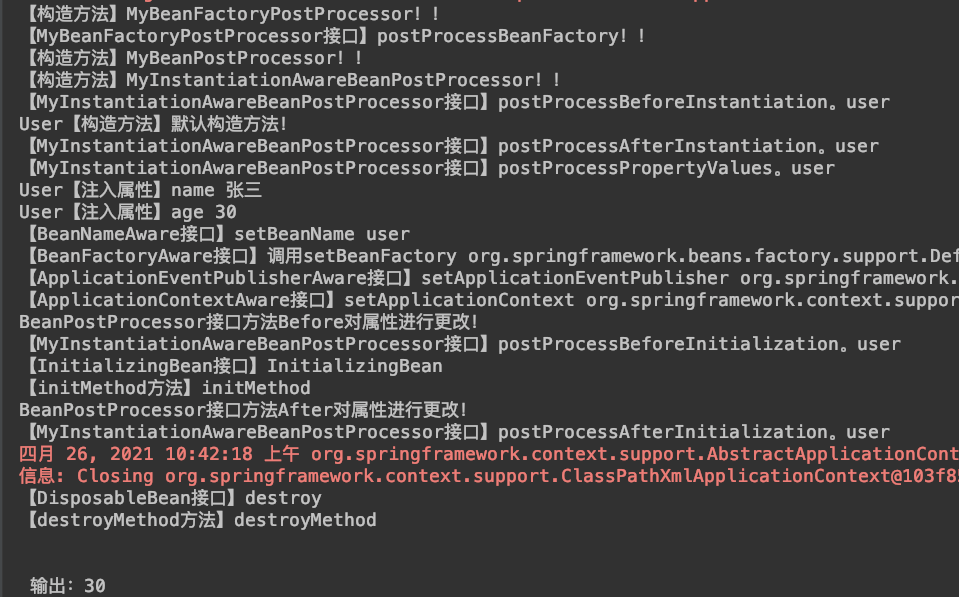这篇文章给大家介绍Spring Bean有哪些生命周期,内容非常详细,感兴趣的小伙伴们可以参考借鉴,希望对大家能有所帮助。
生命周期解读:
1. 注册阶段
2. 实例化阶段
3. 初始化阶段
4. 销毁阶段
注册阶段主要任务是通过各种BeanDefinitionReader读取扫描各种配置来源信息(xml文件、注解等),并转换为BeanDefinition的过程。
BeanDefinition可以理解为类的定义,描述一个类的基本情况,比较像我们注册某些网站时的基本信息,比如需要填写姓名、住址、出生日期等。
最终会将我们扫描到的类整体注册到一个DefaultListableBeanFactory的Map容器中,便于我们之后获取使用。
public class DefaultListableBeanFactory extends AbstractAutowireCapableBeanFactory implements ConfigurableListableBeanFactory, BeanDefinitionRegistry, Serializable {
//存储注册信息的BeanDefinition
private final Map<String, BeanDefinition> beanDefinitionMap = new ConcurrentHashMap<>(256);
//beanDefinitionMap的数据结构是ConcurrentHashMap,因此不能保证顺序,为了记录注册的顺序,这里使用了ArrayList类型beanDefinitionNames用来记录注册顺序
private volatile List<String> beanDefinitionNames = new ArrayList<>(256);
//省略部分代码.......
@Override
public void registerBeanDefinition(String beanName, BeanDefinition beanDefinition) throws BeanDefinitionStoreException {
//省略判断代码.......
// Still in startup registration phase
this.beanDefinitionMap.put(beanName, beanDefinition);
this.beanDefinitionNames.add(beanName);
}
}在实例化阶段,Spring主要将BeanDefinition转换为实例Bean,并放在包装类BeanWrapper中。
无论是否设置Bean的懒加载方式,最后都会通过AbstractBeanFactory.getBean()方法进行实例化,并进入到AbstractAutowireCapableBeanFactory.createBean()方法。
public abstract class AbstractAutowireCapableBeanFactory extends AbstractBeanFactory implements AutowireCapableBeanFactory {
//省略部分代码......
@Nullable
protected Object resolveBeforeInstantiation(String beanName, RootBeanDefinition mbd) {
Object bean = null;
if (!Boolean.FALSE.equals(mbd.beforeInstantiationResolved)) {
// Make sure bean class is actually resolved at this point.
if (!mbd.isSynthetic() && hasInstantiationAwareBeanPostProcessors()) {
Class<?> targetType = determineTargetType(beanName, mbd);
if (targetType != null) {
//实例化前处理器
bean = applyBeanPostProcessorsBeforeInstantiation(targetType, beanName);
if (bean != null) {
//实例化后处理器
bean = applyBeanPostProcessorsAfterInitialization(bean, beanName);
}
}
}
mbd.beforeInstantiationResolved = (bean != null);
}
return bean;
}
//省略部分代码......
}在实例化阶段AbstractAutowireCapableBeanFactory.createBeanInstance()完成Bean的创建,并放到BeanWrapper中。
初始化阶段主要是在返回Bean之前做一些处理,主要由AbstractAutowireCapableBeanFactory.initializeBean()方法实现。
public abstract class AbstractAutowireCapableBeanFactory extends AbstractBeanFactory implements AutowireCapableBeanFactory {
//省略部分代码......
//真正创建Bean的方法
protected Object doCreateBean(final String beanName, final RootBeanDefinition mbd, final @Nullable Object[] args)
throws BeanCreationException {
//省略部分代码......
// Initialize the bean instance.
//Bean对象的初始化,依赖注入在此触发
//这个exposedObject在初始化完成之后返回作为依赖注入完成后的Bean
Object exposedObject = bean;
try {
//将Bean实例对象封装,并且Bean定义中配置的属性值赋值给实例对象
populateBean(beanName, mbd, instanceWrapper);
//初始化Bean对象
exposedObject = initializeBean(beanName, exposedObject, mbd);
}
catch (Throwable ex) {
if (ex instanceof BeanCreationException && beanName.equals(((BeanCreationException) ex).getBeanName())) {
throw (BeanCreationException) ex;
}
else {
throw new BeanCreationException(
mbd.getResourceDescription(), beanName, "Initialization of bean failed", ex);
}
}
//省略部分代码......
return exposedObject;
}
//初始容器创建的Bean实例对象,为其添加BeanPostProcessor后置处理器
protected Object initializeBean(final String beanName, final Object bean, @Nullable RootBeanDefinition mbd) {
//JDK的安全机制验证权限
if (System.getSecurityManager() != null) {
//实现PrivilegedAction接口的匿名内部类
AccessController.doPrivileged((PrivilegedAction<Object>) () -> {
invokeAwareMethods(beanName, bean);
return null;
}, getAccessControlContext());
}
else {
//为Bean实例对象包装相关属性,如名称,类加载器,所属容器等信息
invokeAwareMethods(beanName, bean);
}
Object wrappedBean = bean;
//对BeanPostProcessor后置处理器的postProcessBeforeInitialization
//回调方法的调用,为Bean实例初始化前做一些处理
if (mbd == null || !mbd.isSynthetic()) {
wrappedBean = applyBeanPostProcessorsBeforeInitialization(wrappedBean, beanName);
}
//调用Bean实例对象初始化的方法,这个初始化方法是在Spring Bean定义配置
//文件中通过init-method属性指定的
try {
invokeInitMethods(beanName, wrappedBean, mbd);
}
catch (Throwable ex) {
throw new BeanCreationException(
(mbd != null ? mbd.getResourceDescription() : null),
beanName, "Invocation of init method failed", ex);
}
//对BeanPostProcessor后置处理器的postProcessAfterInitialization
//回调方法的调用,为Bean实例初始化之后做一些处理
if (mbd == null || !mbd.isSynthetic()) {
wrappedBean = applyBeanPostProcessorsAfterInitialization(wrappedBean, beanName);
}
return wrappedBean;
}
//省略部分代码......
}一般是在ApplicationContext关闭的时候调用,也就是AbstractApplicationContext.close() 方法。
在注册的时候Spring通过适配器模式包装了一个类DisposableBeanAdapter,在销毁阶段的时候会获得这个类,进而调用到DisposableBeanAdapter.destroy()方法:
class DisposableBeanAdapter implements DisposableBean, Runnable, Serializable {
//省略部分代码......
@Override
public void destroy() {
if (!CollectionUtils.isEmpty(this.beanPostProcessors)) {
for (DestructionAwareBeanPostProcessor processor : this.beanPostProcessors) {
processor.postProcessBeforeDestruction(this.bean, this.beanName);
}
}
if (this.invokeDisposableBean) {
if (logger.isDebugEnabled()) {
logger.debug("Invoking destroy() on bean with name '" + this.beanName + "'");
}
try {
if (System.getSecurityManager() != null) {
AccessController.doPrivileged((PrivilegedExceptionAction<Object>) () -> {
((DisposableBean) bean).destroy();
return null;
}, acc);
}
else {
((DisposableBean) bean).destroy();
}
}
catch (Throwable ex) {
String msg = "Invocation of destroy method failed on bean with name '" + this.beanName + "'";
if (logger.isDebugEnabled()) {
logger.warn(msg, ex);
}
else {
logger.warn(msg + ": " + ex);
}
}
}
if (this.destroyMethod != null) {
invokeCustomDestroyMethod(this.destroyMethod);
}
else if (this.destroyMethodName != null) {
Method methodToCall = determineDestroyMethod(this.destroyMethodName);
if (methodToCall != null) {
invokeCustomDestroyMethod(methodToCall);
}
}
}
//省略部分代码......
}销毁阶段主要包括三个销毁途径,按照执行顺序:
@PreDestroy注解,主要通过DestructionAwareBeanPostProcessor实现
实现DisposableBean接口,主要通过DisposableBean.destroy()实现
自定义销毁方 DisposableBeanAdapter.invokeCustomDestroyMethod()实现
下边通过一个简单实例来做一个简单测试。
import org.springframework.beans.BeansException;
import org.springframework.beans.factory.*;
import org.springframework.context.ApplicationContext;
import org.springframework.context.ApplicationContextAware;
import org.springframework.context.ApplicationEventPublisher;
import org.springframework.context.ApplicationEventPublisherAware;
/**
* @Author: maomao
* @Date: 2021-04-18 20:50
*/
public class User implements BeanFactoryAware, BeanNameAware, InitializingBean, DisposableBean, ApplicationContextAware, ApplicationEventPublisherAware {
private String name;
private int age;
private BeanFactory beanFactory;
private String beanName;
public User(){
System.out.println("User【构造方法】默认构造方法!");
}
public String getName() {
return name;
}
public void setName(String name) {
this.name = name;
System.out.println("User【注入属性】name " + name);
}
public int getAge() {
return age;
}
public void setAge(int age) {
this.age = age;
System.out.println("User【注入属性】age " + age);
}
@Override
public void setBeanFactory(BeanFactory beanFactory) throws BeansException {
System.out.println("【BeanFactoryAware接口】调用setBeanFactory " + beanFactory);
this.beanFactory = beanFactory;
}
@Override
public void setBeanName(String name) {
System.out.println("【BeanNameAware接口】setBeanName " + name);
this.beanName = name;
}
@Override
public void destroy() throws Exception {
System.out.println("【DisposableBean接口】destroy");
}
@Override
public void afterPropertiesSet() throws Exception {
System.out.println("【InitializingBean接口】InitializingBean");
}
public void initMethod(){
System.out.println("【initMethod方法】initMethod");
}
public void destroyMethod(){
System.out.println("【destroyMethod方法】destroyMethod");
}
@Override
public void setApplicationContext(ApplicationContext applicationContext) throws BeansException {
System.out.println("【ApplicationContextAware接口】setApplicationContext " + applicationContext);
}
@Override
public void setApplicationEventPublisher(ApplicationEventPublisher applicationEventPublisher) {
System.out.println("【ApplicationEventPublisherAware接口】setApplicationEventPublisher " + applicationEventPublisher);
}
}application.xml配置
<?xml version="1.0" encoding="UTF-8"?>
<beans xmlns="http://www.springframework.org/schema/beans"
xmlns:xsi="http://www.w3.org/2001/XMLSchema-instance"
xsi:schemaLocation="http://www.springframework.org/schema/beans http://www.springframework.org/schema/beans/spring-beans.xsd">
<bean id="beanPostProcessor" class="com.freecloud.spring.lifecycle.MyBeanPostProcessor"></bean>
<bean id="instantiationAwareBeanPostProcessor" class="com.freecloud.spring.lifecycle.MyInstantiationAwareBeanPostProcessor"></bean>
<bean id="beanFactoryPostProcessor" class="com.freecloud.spring.lifecycle.MyBeanFactoryPostProcessor"></bean>
<bean id="user" class="com.freecloud.spring.lifecycle.User" init-method="initMethod" destroy-method="destroyMethod" >
<property name="name" value="张三"></property>
<property name="age" value="18"></property>
</bean>
</beans>测试类:
import org.junit.Before;
import org.junit.Test;
import org.springframework.context.ConfigurableApplicationContext;
import org.springframework.context.support.ClassPathXmlApplicationContext;
/**
* @Author: maomao
* @Date: 2021-04-18 20:57
*/
public class LifecycleTest {
private ConfigurableApplicationContext applicationContext;
@Before
public void init(){
applicationContext = new ClassPathXmlApplicationContext("application.xml");
}
@Test
public void Test(){
User user = applicationContext.getBean("user",User.class);
//ConfigurableApplicationContext.close()将关闭该应用程序的上下文,释放所有资源,并销毁所有缓存的单例bean
// 只用于destroy演示
applicationContext.close();
//applicationContext.registerShutdownHook();
System.out.println("\n\n 输出:" + user.getAge());
}
}最终结果:

关于Spring Bean有哪些生命周期就分享到这里了,希望以上内容可以对大家有一定的帮助,可以学到更多知识。如果觉得文章不错,可以把它分享出去让更多的人看到。
亿速云「云服务器」,即开即用、新一代英特尔至强铂金CPU、三副本存储NVMe SSD云盘,价格低至29元/月。点击查看>>
免责声明:本站发布的内容(图片、视频和文字)以原创、转载和分享为主,文章观点不代表本网站立场,如果涉及侵权请联系站长邮箱:is@yisu.com进行举报,并提供相关证据,一经查实,将立刻删除涉嫌侵权内容。
原文链接:https://my.oschina.net/u/1019754/blog/5031820